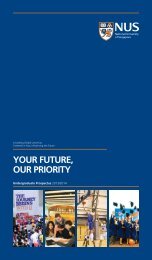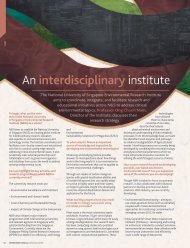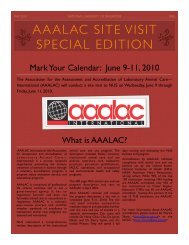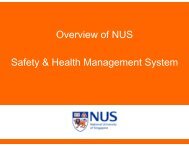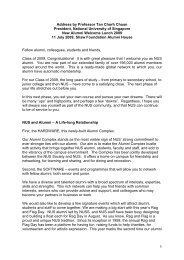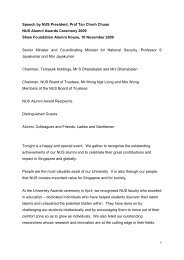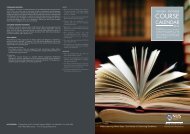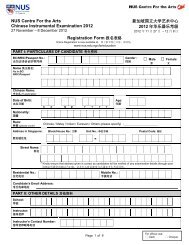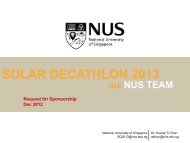(Naja naja) Venom - National University of Singapore
(Naja naja) Venom - National University of Singapore
(Naja naja) Venom - National University of Singapore
You also want an ePaper? Increase the reach of your titles
YUMPU automatically turns print PDFs into web optimized ePapers that Google loves.
Comparative Proteomic Analysis Involving Captive Pakistan Cobra<br />
(<strong>Naja</strong> <strong>naja</strong>) <strong>Venom</strong><br />
Doley R 1 , Kini RM 2<br />
Modahl CM 3<br />
Department <strong>of</strong> Biological Sciences, Faculty <strong>of</strong> Science, <strong>National</strong> <strong>University</strong> <strong>of</strong><br />
<strong>Singapore</strong>, 10 Kent Ridge Road, <strong>Singapore</strong> 117546<br />
College <strong>of</strong> Agricultural, <strong>University</strong> <strong>of</strong> Kentucky, Lexington, Kentucky, 40506<br />
ABSTRACT<br />
<strong>Venom</strong> production facilities keep established colonies <strong>of</strong> captive snakes to obtain<br />
venom for research and antiserum purposes. These captive colonies alleviate collection<br />
pressures put on wild populations. Since some venomous snakes, including the Pakistan<br />
cobra, <strong>Naja</strong> <strong>naja</strong>, have strict regulations involving importation, only a certain amount <strong>of</strong><br />
initial individuals are used to construct these colonies. This arrangement allows for a<br />
decrease in genetic diversity and a closer relation between snakes.<br />
With the use <strong>of</strong> gradient SDS-PAGE gels and reverse phase liquid chromatography<br />
mass spectrometry (LC/MS), venom from fifteen N. <strong>naja</strong> originating from two separate<br />
venom production colonies were analyzed. <strong>Venom</strong> variation has been well documented in<br />
snakes and has been found to be the result <strong>of</strong> many factors, including diet, geographic<br />
range, and individual differences. However, the affect <strong>of</strong> long-term captivity on venom<br />
variation has not been well studied. By identifying intraspecific venom variation known<br />
to exist, such as ontogenetic, population isolation, and sibling changes in venom<br />
composition, a better understanding <strong>of</strong> the venom from captive snakes is developed.<br />
1 Post Doctoral Fellow<br />
2 Senior Lecturer<br />
3 Undergraduate Student
This study has practical applications in the field <strong>of</strong> venom research and antiserum<br />
production since it is from these long-term captive colonies that venom is collected for<br />
these purposes.<br />
INTRODUCTION<br />
In this study, the venom from a total <strong>of</strong> fifteen N. <strong>naja</strong> housed at two different venom<br />
production facilities is investigated. The cobras maintained at the Kentucky Reptile Zoo<br />
and Latoxan are at least second generation captive animals, and there have not been any<br />
studies done on the venom from snakes that have been raised in captive conditions for<br />
that length <strong>of</strong> time.<br />
<strong>Venom</strong> is very variable in composition and expression. Intraspecific venom variation<br />
has been documented to be the result <strong>of</strong> many factors, including diet (Daltry et al.,<br />
1996b), isolation (Williams et al, 1988), geographic range (Glen et al, 1983), and even<br />
differences among siblings (Menezes et al., 2006). In fact, the venom from the same<br />
individual can be subject to ontogenetic changes (Daltry et al., 1999).<br />
However, the effect <strong>of</strong> long-term captivity and inbreeding on venom variation has not<br />
been studied. The experimental objective <strong>of</strong> this study is to identify intraspecific variation<br />
experienced by N. <strong>naja</strong> kept in a long-term captive situation.<br />
METHODS<br />
N. <strong>naja</strong> venom was obtained from two sources and each venom sample was collected<br />
from a single cobra (no pooled samples were used). Collected venom was lyophilized<br />
(10-18 mg dry weight) and reconstituted with lx SDS/Glycine Running Buffer (1 mg/ml).
Premade SDS-PAGE 4-20% Tris-HCl gradient gel was used to separate and document<br />
the protein content <strong>of</strong> the venom from N. <strong>naja</strong> originating from the Kentucky Reptile<br />
Zoo.<br />
Reverse phase liquid chromatography (RPLC) was done with 150 µl <strong>of</strong> venom sample<br />
(l mg/ml) injected into an RP-Jupiter C18 (10µ, 300 Ǻ, 10 mm X 250 mm) column<br />
equilibrated with 0.1% trifluoroacetic acid (TFA). RPLC results were than connected to<br />
an electrospray ionization mass spectrum to indentify the protein composition <strong>of</strong> all N.<br />
<strong>naja</strong> individuals originating from Latoxan.<br />
RESULTS AND DISCUSSION<br />
The overall goal <strong>of</strong> this project was to identify venom variation observed among<br />
different populations, age groups (ontogenetic), and siblings. All <strong>of</strong> these levels <strong>of</strong><br />
variation have been identified in other studies (see Introduction section), but the<br />
composition <strong>of</strong> venom obtained from long-term captive snakes has not been reviewed.<br />
Of the three levels <strong>of</strong> variation considered, only one is able to be distinguished, and<br />
that is at the level <strong>of</strong> sibling and individual variation.<br />
Since different methods were used to analyze the venom composition from cobras at<br />
the Kentucky Reptile Zoo and cobras from Latoxan, the two can’t be directly compared.<br />
Therefore, population variation can’t be shown in this study.<br />
The cobras from Latoxan were all siblings from the same parents, just two separate<br />
litters. Cobras A, B, and D were born on 01/09/01 and cobras C, E, and F were born on<br />
01/11/02. <strong>Venom</strong> from each cobra in the different litters was examined in hopes <strong>of</strong><br />
finding ontogenetic venom variation trends, but none were found. It is possible that only<br />
a year difference between the <strong>of</strong>fspring is insignificant.
The only clear variation observed was between siblings. There were variations<br />
between all the Latoxan cobras in the study, none <strong>of</strong> the venom pr<strong>of</strong>iles were identical to<br />
another, but some variations were more prominent than others.<br />
ACKNOWNLEDGEMENTS<br />
I will forever be indebted to Pr<strong>of</strong> RM Kini for allowing me the chance to spend a little<br />
over four months working in his lab. I also couldn’t have completed this project without<br />
the guidance <strong>of</strong> lab member Robin Doley, my advisor Bruce Webb at the <strong>University</strong> <strong>of</strong><br />
Kentucky, and Jim Harrison and Kristen Wiley from the Kentucky Reptile Zoo who<br />
donated N. <strong>naja</strong> venom for my research.<br />
REFERANCES<br />
Daltry JC, Wüster W, Thorpe RS. 1996b. Diet and snake venom evolution. Nature. 8:<br />
379(6565):537-40.<br />
Daltry JC, Ponnudurai G, Shin CK, Tan NH, Thorpe RS, Wüster W. 1999.<br />
Electrophoretic pr<strong>of</strong>iles and biological activities: intraspecific variation in the venom <strong>of</strong><br />
the Malayan pit viper (Calloselasma rhodostoma). Toxicon. 34:1. 67-79.<br />
Glen JL and Straight R. 1978. Mojave rattlesnake Crotalus scutulatus scutulatus<br />
venom: variation in toxicity with geographical origin. Toxicon. 16: 81-84.<br />
Menezes M. C, Furtado M. F, Travaglia-Cardoso S. R, Camargo A C.M, and Serrano<br />
S. M.T. 2006. Sex-based individual variation <strong>of</strong> snake venom proteome among eighteen<br />
Bothrops jararaca siblings. Toxicon 47: 304-312.<br />
Williams V, White J, Schwaner T.D, and Sparrow A. 1988. Variation in venom<br />
proteins from isolated populations <strong>of</strong> tiger snakes (Notechis ater niger, N. scutatus) in<br />
south Australia. Toxicon 26: 1067-1075.



